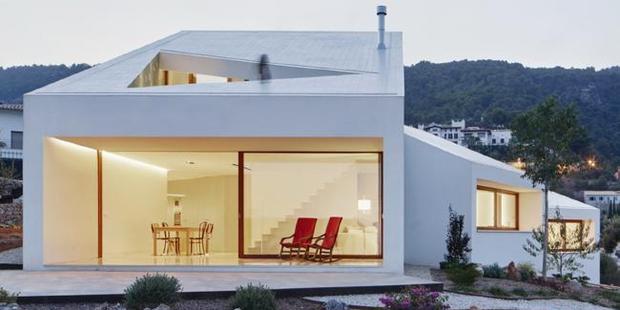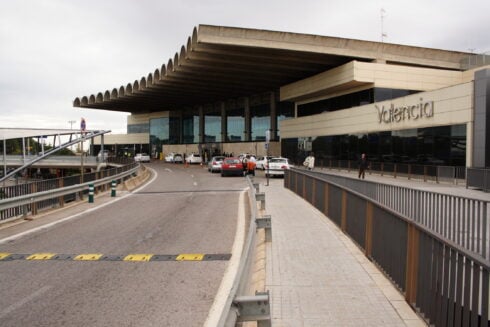 IT’S official: The best house in the world is in Spain!
IT’S official: The best house in the world is in Spain!
Claiming the top gong at the World Architecture Festival, MM House in Palma, Mallorca, fought off competition from luxury properties around the globe.
Designed by Mallorcan architect firm Oliver Hernaiz Architecture Lab (OHLAB), the house is constructed from a series of white boxes stacked on top of one another in a modern take on the classic pueblo blanco.
Each box was purposely constructed to mark the different sections of the property, separating the kitchen, living room, dining room and the properties two bedrooms.
Designed with an ‘environmental conscience’, a spokesman for OHLAB said that modern architects have a ‘moral responsibility’ to care for their surroundings.
 “MM House is designed as a home that promotes environmental and sustainability values,” he said. “The pitched roofs have a system for collecting rainwater – three of them collect water for irrigation and general use while a fourth collects water for consumption.”
“MM House is designed as a home that promotes environmental and sustainability values,” he said. “The pitched roofs have a system for collecting rainwater – three of them collect water for irrigation and general use while a fourth collects water for consumption.”
It also features intelligent technology and insulation systems to ensure heating and cooling is energy efficient and sustainable.
Each box is also positioned to take advantage of the natural light and surroundings.
The judges of the World Architecture Festival Awards said MM House ‘transcends the beauty of the everyday, as well as being an inspiring paradigm for the art of the possible’.
Click here to read more News from The Olive Press.









Is it legal?
This particular effort, though commendable, is not sustainable. Educational efforts should be at the municipal level where poorly educated aparejadoes, técnicos, make bad decisions based on ignorance, corruption and politics.
Very simple technological efforts can be made now that improve the sustainability and climatic efficiency of houses – even retro-fitting – that do not entail hiring hi-tech, expensive engineers using state-of-the-art systems: foundation design, house orientation with climate in mind, thickness of walls, window size and orientation, types of insulation based on heating-chilling cycle, etc. These can be as simple as wall materials and thickness, foundation sealing, etc.
Expecting the OHLAB house to effect real change is a bit like expecting formula rally cars to have an affect on mass market autos. Most people will notice the glitz, shape and exterior aspect, but not grasp that they, themselves, could build into their own homes many sustainable features for 10s of thousands less money. Changes need to be at the municipal level, but due to the Constitution’s capitulation to municipal politicians and corporate interests in 1978, won’t be made till the Madrid government amends the land decision clauses.
it seems some geniuses here think that this example “is not sustainable”…mein gott.
what this project demonstrates is that with a simple partido arquitectonico, dividing the house in 4 volumes rotated in one axis, which contains 4 different areas, you can solve most of the problems raised.
clearly these geniuses know zilch about architecture.
or engineering.
or anything
If there is any value in a sustainable construction project, it is the necessity of widely accessible technology – not of glitz and expensive systems that are largely unaffordable by the general population.
Putting rooms around a central axis where electrical and plumbing systems run is hardly innovative, nor does it solve sustainability problems, though it does save cost of materials, and for that reason is quite normal in all constructions.
That this house is considered somehow innovative merely points out how far behind the country’s practitioners and would-be critics are. This house is a marketing statement for the expensive technological systems within – probably imported from Germany and France. Architecture should not be just ‘the look’ of a building: it must also integrate human function, engineering, cost, sustainability, and many other factors pertaining to the concept of the ‘envelope’. Otherwise it is merely decorative arts without teleological purpose.
what a good project has to comply is to meet all the requirements of the programa de necesidades, made for a specific client .
sustainability in this case is just 1 (ONE) of them.
what the jury has to evaluate in a concurso, competition, etc is the whole project, which, according to the jury, was better than its competitors.
It doesnt mean that it is the best house in the world, of course.
now it is funny to read some posts here, it seems neither the journo nor the posters know too much about architecture.
Sustainability is always the foremost concern of responsible architects. What you are referring to is the sad state of architectural practice in places largely devoid of properly trained architecture with knowledge of engineering, aesthetics, social responsibility and creative ability. Your opinion might be interesting if informed by knowledge and practice.
clearly your opinion is not informed by knowledge and practice, which is logic since you are neither an architect nor an engineer.
environmental sustainability is an important point, BUT NOT more important than tectonicity, functionality, etc.
depending on the scale of the projects, some points are more important than others.
in a regional hospital, airports, or other projects of escala media, the esquema de circulación diferenciada is one of the most important requierements, a lot more than sustainability.
“Best house in the world” is about a single occupancy house, not commercial special use medium to large scale projects. All the things you mention, of course, count in any project. But in our age of diminishing materials, high pollution, water shortage and climate change, sustainability certainly figures near or on top of projects of a repeatable nature such as domestic architecture. Moreover, if airports, factories shopping malls, hospitals and other medium to large scale projects are to be serviceable and economically viable after a few years, they, too, must be sustainable.
But I suspect you are just hell-bent on doing your usual snarkey-last-word-trolling-I-win thing: so bray on: few architects, engineers or ecologists or rationally thinking people take your fanciful, cerebral gyrations seriously. We don’t.
Wonder if the “World Architecture Award” for “best house in the world” would ever go to an individual who didn’t belong to their recognised gang? – (Sorry, profession)